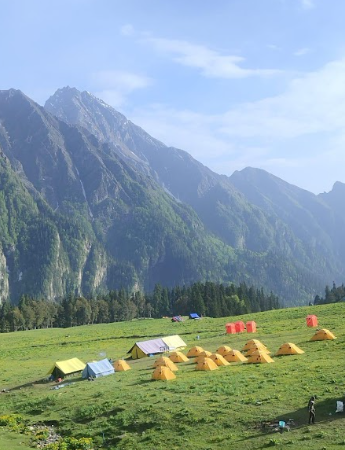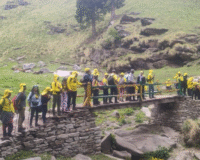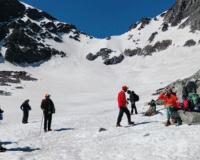Buran Pass Trek September 2025 – Route, Weather & Guide
If you are planning an unforgettable Himalaya adventure, Buran Pass Trek should be high on your list in September 2025. Whether you are an experienced trekker or an enthusiastic start, September is one of the best times to experience this beautiful route. In this blog we cover all the things you need to know – from weather conditions and trail highlights to fitness requirements and necessary equipment. Let’s see why September 2025 is the ideal time to take the Buran pass. Where is Buran Pass? The Buran Pass is located in the Shimla district of Himachal Pradesh. It acts as a high-height mountain corridor connecting the Jungle Village in the Pabar Valley to the Barua village of Baspa Valley near the popular city of Sangla. Around 15,000 feet above sea level, passport, passport, snow-covered peaks, huge green grasslands, and tracts with panoramic views of old paths used by local people for centuries. Although not known as other trips such as Hampa Pass or Roopin Pass, its raw beauty and cultural prosperity make it a rewarding experience for some more authentic fans. Why Trek the Buran Pass in September? September in Himachal Pradesh is an excellent month for high altitude, especially the Buran Pass. The monsoon rain usually retires at the end of August, which overhauls the green landscape, clear skies, and fresh trails. The day temperature is comfortable, between 12 to 18 ° C, while the night temperature can take a dip up to 0–5 ° C, especially in high camps. The grasslands are still green, with flowers in the valleys, and there is a risk of landslides or heavy rain. In addition, September Peak is not as crowded as the summer months, so you can enjoy the brand in peace, take uninterrupted images, and absorb the natural peace in the region. Trek highlights The journey begins in the bizarre village of the jungle, which is known for its wooden houses and traditional Himachali architecture. When you pass through dense cedar forests and wide grasslands, you come to Dayara, one of the most beautiful open scenarios in Dayara. The next highlight is the Litam valley, where a wide current divides meadows and opens to the ice-covered peaks. From Lithar, you have an alternative to taking a round for the Chandrahan -Lake, a high-altitude glacial lake that is sacred to the locals and provides an extraordinary view. Climbing for Buran Pass stands and challenges itself, but is completely rewarded. Once at the top, you will see a fantastic 360-degree view of the surrounding mountain ranges. The Barua village of Baspa Valley presents a whole new side of Himachal Pradesh, with apple gardens, thick cedar forests and local Kinnuri culture. Trekking distance and travel program The entire trip covers about 40 to 45 kilometers and usually takes 6 to 7 days to complete, except for the journey from the base camp. Most of the travel programs begin with a drive from Shimla to the Jungle, followed by a real trek. Day one usually includes a gradual climb from the jungle to Daya Meadows. The second day, walkers continue to Litam, spending the night near a scary stream with scenes of snow-covered lines. Day three is often used for a side walk for acclimatization or the Chandranhan lake. Day four is the most demanding, including a steep climb for Burn Pass and a descent for River Camp on the other side. The last day includes going ahead in Barua Village and going back to Sangla or Shimla. Exercise and difficulty level Burn Pass Trek has been given the status of medium to moderate. Although the scar is well defined and does not require technical climbing, it involves long-lasting, standing, rising, and high-high conditions. A good level of training is necessary to enjoy the trip and avoid height-strained problems. It is appropriate to start fitness training at least four weeks in advance. Star climbing, running and the main exercises are especially useful. Trekkers should be mentally prepared for the status of the basic camp and sudden change of being. The weather in September 2025 The September region brings the status of ideal trekking. The first week can still get light rainfall, as the Monsun top can be closed, but from the second week the weather is stable. The day temperature is between 12 to 18 ° C, while the night temperature at high altitude can take a dip at the cold point. The sky is generally clear and offers fantastic views of the Doldhar and Kinnur series. There is no possibility of snow during this time, even if you can withstand the old ice patches nearby. It is recommended to check appropriate hot layers and weather updates before departure. What to pack Packing is required properly for Trek. A good pair of waterproof pulling shoes with catch is a necessary. It is important to lay clothes, start with thermal, followed by wool and jacket below. Fast drying T-shirts and pulling pants are better than cotton. Precipitation, gloves, wool cap, sunglasses, sunscreen, a headlamp and a personal medical set should be included. Although September is not a heavy snow season, the cold in high camps can be acute, then give. Directed Trek or DIY? While some experienced draws, this trek -solo, which chooses most for guided groups due to scars and complexity of unexpected weather. Local guides not only provide knowledge of the area, but also provide insight into flora, organisms and cultural practices in the region. In addition, food, tent and campsite logistics are handled by professional trekking organizers, so you can focus on experience instead of management. How to reach the jungle The jungle is a base town where the trip begins. It can be reached from Shimla via Road, which is well connected to Chandigarh and Delhi with road and rail. From Shimla, drive or rent a taxi to Rohru, and then move towards Tangnu and finally towards the jungle. The road from Rohru to Jungle is narrow and curved, so



